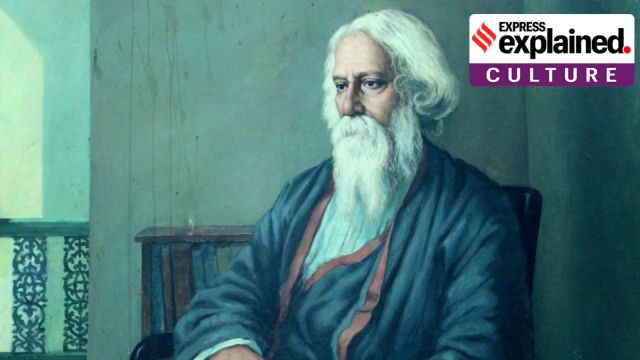When Karnataka BJP MP and former Speaker of the state Legislative Assembly, Vishweshwar Hegde Kageri, said last week that Nobel laureate Rabindranath Tagore had composed ‘Jana Gana Mana’ as a “welcome song for the British officials”, he ruffled some feathers, prompting West Bengal’s ruling Trinamool Congress to hold protests calling for action.
But Hegde wasn’t the first to make these remarks, which were made at an event to mark the 150th anniversary of India’s national song, ‘Vande Mataram’. Politicians, a few scholars and even a former Supreme Court judge have previously made similar claims, arguing that India’s national anthem was an ode to British rule and emphasised a sense of sycophancy.

More than a decade ago, Kalyan Singh, a BJP leader who was then the Governor of Rajasthan, had even called for the words ‘Jana Gana Mana Adhinayak’ to be replaced with ‘Jana Gana Mana Mangaldayak’, arguing that while the former translated into “Hail the Ruler”, the latter called to mind “one who brought prosperity and joy”.
A song for the Maker
What is undisputed is that India’s national anthem – which is a part of a bigger poem, ‘Bharoto Bhagyo Bidhata’ – was first performed in 1911 during a Delhi Durbar (a grand court) convened in honour of King George V and his wife, Queen Consort Mary, who were visiting India at that time.
Tagore himself commented on the rumours that the song was dedicated to the British monarch. In a letter to his editor and bibliographist Pulin Behari Sen, who had asked him to clear the air, he said that “neither the Fifth nor the Sixth nor any George could be the maker of human destiny through the ages”.
“I had hailed in the song ‘Jana Gana Mana’ that Dispenser of India’s destiny who guides, through all rise and fall, the wayfarers, He who shows the people the way…” the response, written on on November 20, 1937, and preserved in the archives, said.
Indeed, parts of the poem appear to be addressed not to a mortal, but to a divine entity. “Paten obhyudoy bondhur pontha, jug jug dhabito jatri. Ohe chiro-sharothi, taba rathachakre mukhōrito patha dinōratri (Eternal charioteer, thou drivest man’s history / Along the road that is rugged with the rise and fall of nations),” the third stanza of the poem says.
Story continues below this ad
Laying a myth to rest
The late Prof Sabyasachi Bhattacharya, one of the country’s greatest historians, writes in his 2011 book, ‘Rabindranath Tagore: An Interpretation’, that Tagore had indeed been asked to write a welcome for King George V but declined and wrote this poem instead.
“To see George V as the object of worship in place of ‘Dispenser of India’s destiny… Thou King of all Kings’ was not only absurd but also sacrilegious to Tagore,” writes Bhattacharya.
He goes on to say that the myth regarding this song needs to be refuted and laid to rest. “It is on record that the song was written on December 11, 1911. On December 12, 1911, the Delhi Durbar met to honour King George V. Obviously, a poem written on December 11 could not be intended for an event the following day,” writes Bhattacharya.
‘Jana Gana Mana’ was sung on December 28, 1911, to open the 27th session of the Indian National Congress. The next recorded presentation of the song was in 1912, at the foundation day anniversary of Adi Brahma Samaj.
Story continues below this ad
“The song was included in their list of psalms, Brahma Sangit,” writes Bhattacharya. “He did not write it for the Congress either. It was a hymn to his maker, the guardian of the country’s destiny,” says the historian.
An anthem is born
It was Netaji Subhas Chandra Bose who first decided to use Tagore’s composition, Jana Gana Mana, at the inauguration of the Free India Centre on a cold November day in 1941 in Berlin.
There, it was decided that the Tricolour of the Indian National Congress would be the flag of the independent nation, and Tagore’s composition, Jana Gana Mana, the anthem. It is said that Netaji was divided between Tagore’s song and Muhammad Iqbal’s ‘Sare Jahan Se Achha, Hindustan Hamara’.
“Jana Gana Mana, which defined India as a union of all provinces, languages and religions, was thought to be more suitable to become the National Hymn of our country and was unanimously adopted,” N.G. Ganpuley, a close associate of Netaji, who was present then, writes in ‘Ganpuley’s Memoirs: Author of Netaji in Germany’.
Story continues below this ad
The national anthem was sung for the first time with a full orchestra accompaniment on the occasion of the inauguration of the Indo-German Cultural Society in Hamburg in 1942, he goes on to say. “Gramophone records of this were also made and are still available.”
The journey of Tagore’s song would culminate in the Constituent Assembly on January 24, 1950. The first President of India, Dr Rajendra Prasad, announced: “The composition consisting of the words and music known as Jana Gana Mana is the National Anthem of India, subject to such alterations in the words as the Government may authorise as occasion arises; and the song ‘Vande Mataram’, which has played a historic part in the struggle for Indian freedom, shall be honoured equally with ‘Jana Gana Mana’ and shall have equal status with it.”






































